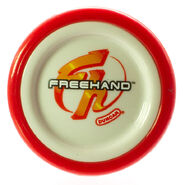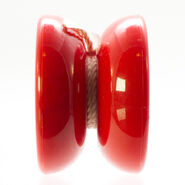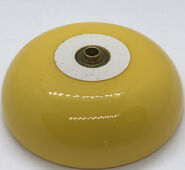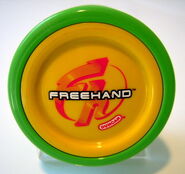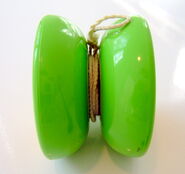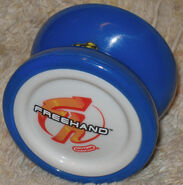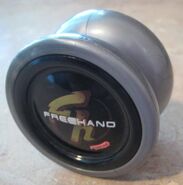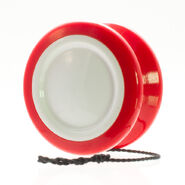- This article refers to the original Freehand yo-yo of 2001, and is numbered 1 to mark it as the first Freehand yo-yo. For the December 2021 release, see Duncan Freehand One
The Duncan Freehand 1 (often abbreviated FH1), sometimes referred to as the Original Freehand, was designed by Steve Brown and was the very first yo-yo to be developed specifically for Freehand (5A) play. It came packaged with a casino die counterweight for this very purpose. Released as part of the Hardcore series, the Freehand 1 was also the first Duncan yo-yo to use the company's Friction Sticker response pad system.
Upon release in 2001, the Freehand 1 was widely renowned as one of the widest yo-yos yet designed at the time, and had put Duncan back on the map. Bringing in a newly popular organic shaped yoyo into the market. Alongside yo-yos such as the SuperYo Renegade, the playability and availability (at the time) of the FH1 enabled many advancements that defined the Mid-School era of yo-yoing. It was also popular for modding. Freehand 1 yo-yos were used by players such as Jason Lee to win the U.S. National Yo-Yo Contest in 2001, as well as Yuuki Spencer when he won at the 2002 World Yo-Yo Contest.
Production of the Freehand 1 came to a halt when the original production mold became irreparably damaged. Given its already high demand before release and and lack of other yoyos close to this design on the market, the original packaged FH1s' prices soared in value as a result. Duncan released a line of new versions of the Freehand since then. In the immediate years that followed came the Freehand 2 (based on the design of the ProYo Turbo Bumble Bee GT), the Hyper Freehand (for the Hyper Yo-Yo line in Japan), and the Freehand Zero, which also became very popular for modding. Duncan would change designs using the Freehand line, but would not fully try to recreate the Freehand 1 until making the Freehand One for its 20th Anniversary of the original Freehand.
The full freehand series line in chronological release dates:
- Freehand 1 (FH1)
- Freehand 2 (FH2)
- Hyper Freehand (HFH)
- Freehand Zero (FH0 / FH Zero)
- Freehand MG (a high-end $400 Magnesium Yo-Yo)
- Metal Freehand Zero (Metal Zero)
- Keychain Freehand (a mini pocket Yo-Yo)
- Freehand Al (Aluminum)
- Freehand Pro
- Freehand (released in 2016)
- Freehand Next Gen
- Freehand One AL
- Freehand One Ti
- Freehand One (20 year anniversary remake of the original FH1)
The Freehand 1 was initially available in red, blue, and yellow. Other colors were available, but less commonly for special editions. For instance, orange is rare, green was sold exclusively at Yoyoguy, and bionic silver also. There were also special edition Freehands sold with custom side caps or in special event editions, such as the Yo-Yo Ninja Boy Freehand at the U.S. Nationals and Worlds.
Photos[]
Trivia[]
- The Freehand 1's design was based on the Trans-Axtion yo-yo, right down to the side caps. However, there are differences;
- For one, the Trans-Axtion used starbursts while the FH1 used friction stickers.
- Two, is the body profile, in which the Trans-Axtion had a wing shape similar to the Yomega Saber Raider, whereas the FH1 had a more traditional Butterfly shape.
- The third, is that the Trans-Axtion used a plastic transaxle sleeve and the FH1 used a ball bearing.
- There is a Freehand 1 that was modified by Playmaxx at their factory to have BPT response and an adjustable string gap. It is currently on exhibit at the Museum of Yo-Yo History.[1]
Freehand prototypes[]
- There were a variety of prototype Freehand yo-yos that had used starbursts of different kinds, especially combination positive/negative starbursts. At the time, Tom Van Dan Elzen, who was the head of Playmaxx, was suing Custom Products for its Performance Ring response pad system, claiming that it infringed on Playmaxx's patent for the Brake Pad Technology. On the topic of response pads, the finalized production model of the Freehand featured Duncan's own Friction Sticker system, which was surprising for some considering the lawsuit between Playmaxx and Custom.
- DocPop was one of the players who had beta-tested the Freehand prototypes, especially with having put together a working unit using one half from a prototype that had combination positive/negative starbursts, and another half from a prototype that used friction stickers, both yo-yos being translucent blue in color. He had wanted side caps on it, but their opaque coloration would not allow the light to pass through. So, he had his friend Skizzy cut out the caps' centers to let the light through.
- Some of the more unusual prototypes featured the company name recessed on the inner hubs, acting as negative starbursts. A company called Yes, Absolutely (this editor kids you not, that is the name!) had used a similar concept for their The End yo-yo.
- The ball bearing Trans-Axtion yo-yos were distributed at the New York Toy Fair as prototypes of the Freehand 1.
External Links[]
- Duncan Freehand 1 at the Museum of Yo-Yo History
- Duncan BPT ASG Freehand 1 at the Museum of Yo-Yo History
- Duncan Bionic Freehand at the Museum of Yo-Yo History
- Duncan Bionic Ninja Boy Freehand (2001 U.S. Nationals) at the Museum of Yo-Yo History
- Duncan Ninja Boy Freehand (2001 Worlds) at the Museum of Yo-Yo History
- Duncan FH1 @ cornellouis' Instagram page
